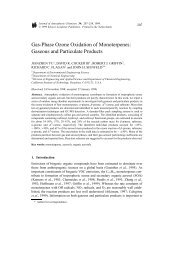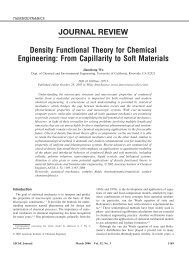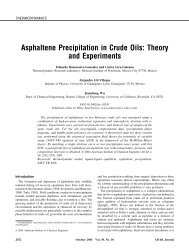DEVELOPMENT OF REVISED SAPRC AROMATICS MECHANISMS
DEVELOPMENT OF REVISED SAPRC AROMATICS MECHANISMS
DEVELOPMENT OF REVISED SAPRC AROMATICS MECHANISMS
You also want an ePaper? Increase the reach of your titles
YUMPU automatically turns print PDFs into web optimized ePapers that Google loves.
Table 2 (continued)<br />
Tuazon et al (1985), as recommended by Calvert et al (2002). The model species xAFG4 is added<br />
to represent the formation of AFG4 following reactions of peroxy radicals with NO (Carter,<br />
2010a,b).<br />
7 The CRES model species is now used to represent only reactions of cresols formed from toluene<br />
and lumped phenolic products formed from the lumped phenoxy radical model species BZO, not<br />
all phenolic compounds. As with <strong>SAPRC</strong>-07, its mechanism is derived based on laboratory and<br />
chamber data for o-cresol.<br />
8 Rate constant is IUPAC (2008b) recommendation for OH + o-cresol. Parameterized mechanism<br />
derived and adjusted to fit results of environmental chamber experiments with o-cresol as<br />
discussed in the text and in Table 7.<br />
9 Rate constant is IUPAC (2008c) recommendation for NO 3 + o-cresol. Mechanism is based on the<br />
parameterized mechanism derived for the OH reaction, but with HNO 3 as an additional product.<br />
10 The PHEN model species is used to represent phenol formed from benzene; CRES is no longer<br />
used for this purpose.<br />
11 Rate constant is IUPAC (2008d) recommendation for OH + phenol. Parameterized mechanism<br />
derived and adjusted to fit results of environmental chamber experiments with phenol as<br />
discussed in the text and in Table 7.<br />
12 Rate constant is IUPAC (2008g) recommendation for NO 3 + phenol. Mechanism is based on the<br />
parameterized mechanism derived for the OH reaction, but with HNO 3 as an additional product.<br />
13 The XYNL model species is used to represent phenolic products formed from xylenes and all<br />
other C 8+ aromatics, including ethylbenzene. Its mechanism is derived based on chamber and<br />
laboratory data for 2,4-dimethyl phenol, a phenolic product formed in the reactions of xylenes.<br />
14 Rate constant is from Thüner et al (2004) for 2,4-dimethyl phenol. Parameterized mechanism<br />
derived and adjusted to fit results of environmental chamber experiments with 2,4-dimethyl<br />
phenol as discussed in the text and in Table 7.<br />
15 Rate constant is from Thüner et al (2004) for 2,4-dimethyl phenol. Mechanism is based on the<br />
parameterized mechanism derived for the OH reaction, but with HNO 3 as an additional product.<br />
16 The CATL model species is used to represent dihydroxy phenol products formed from the<br />
reactions of phenols. The rate constant used for the OH radical reaction is based on the IUPAC<br />
(2008e) for 1,2-dihydroxy-3-methyl benzene. Its mechanism is based roughly on the<br />
parameterized mechanisms derived for phenolic products as described in Table 7. The<br />
contribution of Pathway 1 is adjusted to approximately ~40%, to best simulate PM formation in<br />
the phenol, o-cresol, and 2,4-dimethyl phenol chamber experiments, since this is assumed to be<br />
the main SOA formation pathway from phenolic compounds in the SOA version of this<br />
mechanism (Carter et al, 2012). There is no information or useable chamber data to serve as a<br />
basis for deriving contributions of the other three pathways given in Table 7, so we arbitrarily<br />
assume that all are equally important.<br />
17 The rate constant is based on the IUPAC (2008f) recommendation for 1,2-dihydroxy-3-methyl<br />
benzene. As with the other phenolic compounds, the mechanism is based on the parameterized<br />
mechanism used for the OH reaction, but with HNO 3 as an additional product.<br />
14
















